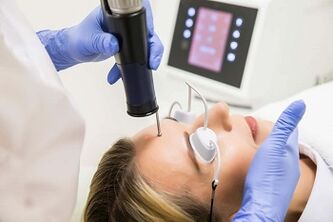
Aging is a natural biological process that affects all tissues of the human body. It is particularly susceptible to the body parts that make up a person's appearance.
For example, facial tissues are constantly exposed to environmental factors, as well as facial, chewing, and speech functions.
The issue of keeping the face young is very important and relevant because it is a person's "business card".
There are many ways to solve this problem today, but according to reviews, laser facial rejuvenation deserves special attention.
The mechanism of laser action on the skin
The essence of this method is the effect of the laser beam on the skin. By splitting into many very thin beams, the laser stream acts on the microscopic areas of the skin and evaporates them. The area of laser action is located at a strictly specified depth. The intact cells located between the areas irradiated by the laser beam begin to actively produce the two main "building materials"-elastin and collagen, because these substances are almost no longer formed independently in the human body as we age.
After laser facial rejuvenation surgery, skin tone improves, eye bags are removed, fine and medium wrinkles disappear or are corrected, and facial contours are tightened. In addition, this method is used to improve the outcome of surgical interventions (for example, in plastic surgery), as well as for laser skin resurfacing.
Types of fractional laser facial rejuvenation
Depending on the depth and nature of the laser beam penetrating the skin, there are two types of procedures:
- Peel off dot-matrix laser skin rejuvenation, when the micro areas of the skin are removed, and then in the process of gradual healing, the damaged micro areas are tightened. Notice the lifting effect after the first procedure;
- Non-exfoliative facial rejuvenation, when the collagen and elastin in the damaged area are also renewed, but the process occurs in the deep layers of the skin, and the laser beam penetrates it without damaging the outer layer. Due to this process, the rejuvenation process will be longer.
Experts can suggest the best variant of this technique, but, according to reviews, it is most effective to combine different types of procedures through laser facial rejuvenation, so that cell renewal not only occurs on the surface of the skin, but also at a deeper level.
Benefits of fractional laser facial rejuvenation
Compared with traditional methods, fractional laser skin rejuvenation has many advantages.
First of all, the effect on the skin is precise, which means that its damage is minimal. Thanks to this, all traces of surgery will disappear within 3-4 days after the intervention.
Secondly, a single course of treatment can treat a large area of skin, while its regenerative resources are not only retained, but also activated, ensuring rapid recovery and long-term positive results.
Third, the procedure does not require anesthesia and can be easily performed on the skin of the shoulder, neck and eye area.
Fourth, there are few side effects. Possible complications such as erythema, slight itching, peeling, burns or skin scabs in the affected area will disappear quickly. Scars, hypopigmentation and hyperpigmentation are extremely rare.
Despite the listed advantages, it is necessary to be familiar with the indications and contraindications of laser facial rejuvenation before performing this procedure.
Indications for laser skin rejuvenation
This method has proven its effectiveness during its existence, but its effect will be particularly pronounced in the case of the following skin problems:
- Spider veins;
- scar;
- Stretch marks;
- Large pores;
- Pigmentation;
- acne;
- wrinkle;
- Sagging, sagging, and fading skin;
- Crow's feet around the eyes.
If any of the issues in the suggestion list are relevant, fractional laser facial rejuvenation will help solve it.
Contraindications of laser facial rejuvenation
In addition to the obvious indications, there are absolute contraindications to this surgery:
- Inflammatory process in the affected area;
- Skin diseases and psoriasis;
- Tendency to form tumor-like scars;
- Herpes lesions in the affected area;
- Close relatives cases of vitiligo;
- Chemical stripping was performed less than 2 weeks before the recommended procedure;
- Systemic blood disease;
- Varicose veins in the laser area;
- Pregnancy and lactation;
- Tumor disease
- Severe forms of coronary heart disease and high blood pressure.
The relative contraindication of laser facial rejuvenation is the appearance of fresh tan, medium and superficial skin less than 3 weeks before surgery.
Laser skin rejuvenation treatment and subsequent actions

Depending on the area of the skin treated and the nature of the problem, the duration of a fractional laser irradiation is 20 to 40 minutes. The operation can only be repeated after 3 or 4 weeks, usually 3-4 courses in total. The greatest positive effect was observed within three months after completing the course. In order to maintain it, it is recommended to repeat it once a year.
After the operation, you may feel a slight burning sensation, but it will go away in about 1-2 hours. The resulting redness and possible slight swelling will last for 1-3 days. At this time, it is recommended to use a topical agent containing depanthenol (for example, ointment or gel). Once the listed symptoms disappear, a cream containing hyaluronic acid must be used.
You can wash and shower on the same day as the laser facial rejuvenation, but it is best to postpone going to the swimming pool or sauna. You can use the foundation again one day after the operation.
A sunscreen with an SPF of 30 or higher must be used because the skin is particularly sensitive to ultraviolet rays at this time.
After laser skin rejuvenation, you should follow the advice of the expert who performed the procedure. The doctor will recommend the best cosmetic preparation according to the skin type and characteristics, and determine the frequency and duration of its use.
























